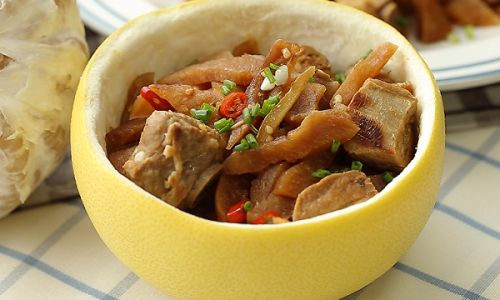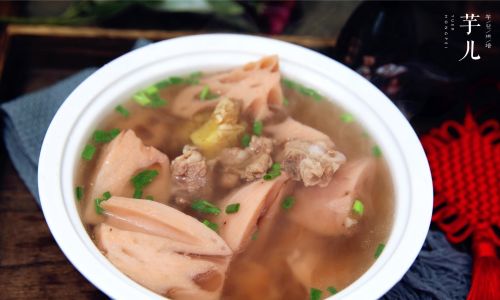Introduction
In the vast realm of culinary arts, exploring unique ingredients and innovative recipes can be an exhilarating journey. One such adventure lies in the realm of traditional Asian cuisine, where every part of a fruit or vegetable is meticulously utilized, transforming humble ingredients into extraordinary dishes. Among these treasures, pomelo peel pork stands out as a delightful surprise, blending the tangy, aromatic essence of pomelo peel with the rich, succulent flavors of pork.
Pomelo (Citrus maxima), often hailed as the “king of citrus,” boasts a thick, bitter-sweet rind that, contrary to popular belief, is edible and highly nutritious when prepared correctly. Rich in antioxidants, vitamins, and minerals, pomelo peel adds a depth of flavor and texture to dishes that is unparalleled. When combined with pork, the result is a harmonious blend of sweet, savory, and slightly tangy notes, making for a meal that is both satisfying and refreshing.
In this guide, we will embark on a culinary adventure, delving into the art of making pomelo peel pork. From selecting the perfect ingredients to mastering the cooking technique, we’ll cover every step in detail, ensuring that you can recreate this exquisite dish in your own kitchen.
Section 1: Ingredients and Preparation

Before diving into the cooking process, it’s crucial to gather all the necessary ingredients and prepare them meticulously. Here’s what you’ll need:
-
Pomelo Peel: Start by selecting a fresh, ripe pomelo. The peel should be firm and free of bruises or mold. Use a sharp knife to carefully peel off the outermost layer, avoiding the bitter white pith as much as possible. Slice the peel into thin strips or small pieces, depending on your preference.
-
Pork: Choose a cut of pork that suits your taste and cooking method. Pork belly or pork shoulder works well for this dish due to their high-fat content, which ensures juicy, tender meat. Cut the pork into bite-sized cubes or slices.
-
Aromatics: Garlic, ginger, and shallots are essential for building the foundation of flavor. Finely chop these ingredients to release their aromatic oils during cooking.
-
Seasonings: Soy sauce, oyster sauce, rice wine (or dry sherry), sugar, salt, white pepper, and sesame oil are the key seasonings. These ingredients will balance and enhance the flavors of the dish.
-
Vegetables (Optional): Bell peppers, carrots, or baby corn can be added for added color, texture, and nutrition.
-
Stock or Water: Chicken or pork stock adds extra depth to the dish, but plain water can be used as a substitute.
Preparation Steps:
-
Blanch Pomelo Peel: To remove excess bitterness and soften the peel, blanch it in boiling water for about 5 minutes. Drain and rinse with cold water to stop the cooking process. Pat the peel dry with paper towels.
-
Marinate the Pork: In a bowl, combine the pork with a few tablespoons of soy sauce, a teaspoon of sugar, a pinch of salt, and a dash of white pepper. Let it marinate for at least 30 minutes to allow the flavors to penetrate the meat.

Section 2: Cooking the Pomelo Peel Pork
With all your ingredients prepared, it’s time to cook. Follow these steps to create a mouthwatering dish:
-
Heat the Oil: In a large wok or heavy-bottomed pan, heat a few tablespoons of vegetable oil over medium-high heat. The oil should be hot but not smoking.
-
Sauté Aromatics: Add the chopped garlic, ginger, and shallots to the hot oil. Stir-fry until fragrant and slightly golden, about 1-2 minutes. Be careful not to burn the aromatics, as this will ruin the flavor of the dish.
-
Add Pork: Raise the heat to high and add the marinated pork to the wok. Stir-fry until the pork is browned on all sides, about 5-7 minutes. This step locks in juices and adds a nice caramelized crust to the meat.
-
Incorporate Pomelo Peel: Add the blanched pomelo peel to the wok, stirring to combine with the pork and aromatics. Pour in enough stock or water to cover the ingredients halfway. This will help steam the pork and soften the peel further.
-
Season and Simmer: Add the remaining soy sauce, oyster sauce, rice wine, and a teaspoon of sugar. Stir well to ensure everything is evenly coated. Lower the heat to a gentle simmer and cover the wok. Let it cook for about 30-40 minutes, stirring occasionally, until the pork is tender and the sauce has thickened slightly.
-
Adjust Seasoning: Taste the sauce and adjust the seasoning with additional salt, sugar, or soy sauce as needed. If the sauce is too thin, you can uncover the wok and let it cook for a few more minutes to reduce.
-
Add Vegetables (if using): In the last 5 minutes of cooking, add any vegetables you’ve chosen. Stir-fry until they are tender but still crisp.
-
Finish with Sesame Oil: Drizzle a teaspoon of sesame oil over the dish and stir to combine. This adds a lovely fragrance and a touch of richness to the final dish.

Section 3: Serving and Enjoying
Once the pomelo peel pork is cooked to perfection, it’s ready to be served. Here are a few tips to enhance your dining experience:
-
Garnish: Sprinkle with chopped green onions, sesame seeds, or a few slices of fresh chili for added color and flavor.
-
Accompaniments: Serve the dish with steamed rice or noodles to soak up the delicious sauce. A side of stir-fried greens or a light salad can also provide a refreshing contrast.
-
Presentation: Arrange the pork and pomelo peel on a serving platter, drizzled with the sauce. The vibrant colors and aromatic steam will make your dish irresistible.
Conclusion
Making pomelo peel pork may seem unconventional, but the result is a dish that is both visually stunning and incredibly delicious. By carefully preparing the ingredients and following the cooking steps, you can transform humble pomelo peel and pork into a culinary masterpiece. This dish not only showcases the versatility of Asian cuisine but also highlights the importance of utilizing every part of an ingredient to create something extraordinary.
As you sit down to enjoy your homemade pomelo peel pork, take a moment to appreciate the journey it took to get there – from selecting the perfect pomelo and pork to the final, savory bite. This dish is not just a meal; it’s a testament to the art of culinary creativity and the beauty of exploring new flavors. So, gather your ingredients, roll up your sleeves, and embark on this culinary adventure. Your taste buds will thank you!






0 comments